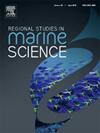根据墨西哥太平洋的微卫星标记和几何形态测定,推断出章鱼hubbsorum的种群结构和喙形变化(Berry, 1953)
IF 2.4
4区 环境科学与生态学
Q3 ECOLOGY
引用次数: 0
摘要
章鱼hubbsorum (Berry, 1953)是墨西哥太平洋最具商业价值的物种;然而,其人口方面和生物学方面很少得到处理。它是一种底栖物种,栖息在潮间带和潮下带的岩石和沙质底物中。虽然一些研究已经解决了与O. hubbsorum的生活史有关的问题,但对离散种群或种群的识别知之甚少。本研究的目的是比较墨西哥太平洋章鱼hubbsorum的种群结构,该种群结构是由微卫星标记和喙形计量学分析推断的。利用微卫星型分子标记对墨西哥太平洋地区章鱼hubbsorum的多样性和种群遗传结构进行了推测。形态学分析基于上喙的几何形态计量学。所有位点均具有多态性,遗传多样性较高。我们的分析表明,地方不存在显著水平的亲属关系。在群体间的遗传分化方面,FST值显示出中度至高度分化的证据,贝叶斯分析显示,在admix和NO admix模型的基础上,至少有6个定义良好的群体。主成分分析也表明存在分化群体。上喙的几何形态测量结果也提供了令人信服的地方之间形态差异的证据。根据我们的研究结果,章鱼hubbsorum在墨西哥太平洋有一个明确的种群。这种认识可以指导有针对性的保护和可持续开发战略的发展。本文章由计算机程序翻译,如有差异,请以英文原文为准。
Population structure and beak shape variation in Octopus hubbsorum (Berry, 1953) inferred from microsatellite markers and geometric morphometry in the Mexican Pacific
Octopus hubbsorum (Berry, 1953) is the most commercially important species in the Mexican Pacific; however, its population aspects and biology have rarely been addressed. It is a benthic species inhabiting rocky and sandy substrates in inter- and subtidal zones. Although some studies have addressed issues related to the life history of O. hubbsorum, little is known about the identification of discrete stocks or populations. The aim of this work was to compare the population structure of the octopus Octopus hubbsorum inferred from microsatellite markers and beak morphometric analysis in the Mexican Pacific. The diversity and population genetic structure of Octopus hubbsorum were inferred using microsatellite-type molecular markers for locations in the Mexican Pacific. Morphological analysis was based on geometric morphometrics of the upper beaks. All the loci were polymorphic, and the genetic diversity was relatively high. Our analysis indicated that the localities do not present significant levels of kinship. With respect to genetic differentiation between populations, the values of FST showed evidence of moderate to high differentiation, and Bayesian analysis revealed at least six well-defined populations on the basis of the ADMIXTURE and NO ADMIXTURE models. Principal Components Analysis also suggested the presence of differentiated groups. Geometric morphometric results of the upper beaks also provided compelling evidence of morphological differentiation between the localities. Based on our results, Octopus hubbsorum has a well-defined population in the Mexican Pacific. This understanding can guide the development of targeted conservation and sustainable exploitation strategies.
求助全文
通过发布文献求助,成功后即可免费获取论文全文。
去求助
来源期刊

Regional Studies in Marine Science
Agricultural and Biological Sciences-Ecology, Evolution, Behavior and Systematics
CiteScore
3.90
自引率
4.80%
发文量
336
审稿时长
69 days
期刊介绍:
REGIONAL STUDIES IN MARINE SCIENCE will publish scientifically sound papers on regional aspects of maritime and marine resources in estuaries, coastal zones, continental shelf, the seas and oceans.
 求助内容:
求助内容: 应助结果提醒方式:
应助结果提醒方式:


